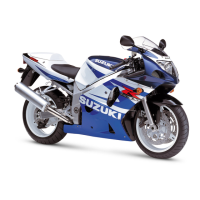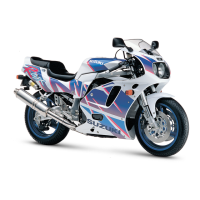5-28 FUEL SYSTEM AND THROTTLE BODY
• Connect a tachometer.
• Start up the engine and keep it running at 1 150 r/min by turn-
ing throttle stop screw 3.
• Turn the air screw 4 of the gauge so that the vacuum acting
on the tube of that hose will bring the steel ball 5 in the tube
to the center line 6.
NOTE:
The vacuum gauge is positioned approx. 30° from the horizontal
level.
• After making sure that the steel ball stays steady at the center
line, disconnect the hose from the #1 throttle body vacuum
nipple and connect the next hose to this vacuum nipple.
• Turn air screw to bring the other steel ball 7 to the center
line.
• Repeat the above process on the third and fourth hoses.
The balancer gauge is now ready for use in balancing the throt-
tle valves.
Throttle valve synchronization
Using the vacuum balancer gauge, inspect the throttle valve
synchronization in the same manner as the digital vacuum
tester. Pay attention to the following points:
The vacuum gauge is positioned approx. 30° from the horizontal
level, and in this position the four balls should be within one ball
dia. If the difference is larger than one ball, turn the balance
adjusting screw on the throttle body and bring the ball to the
same level.
A correctly adjusted throttle valve synchronization has the balls
in the #1 through #4 at the same level.
09913-13121: Vacuum balancer gauge
NOTE:
* During balancing the throttle valves, always set the engine
rpm at 1 150 r/min, using throttle stop screw.
* After balancing the four valves, set the idle rpm to 1 150 r/min
by the throttle stop screw.
Avoid dirt drown into the throttle body while running
the engine without air cleaner box. Dirt drawn into the
engine will damage the internal engine parts.
30˚
SAMPLE

